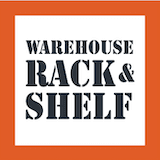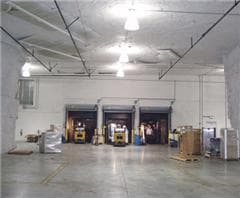In 1996 I had the pleasure of racking Kuna Meat’s new warehouse and distribution center located in Bussen underground warehouse. It was the first time I had ever been in an underground warehouse. The warehouse space was very clean, bright and state of the art. Not like what you might expect in an underground cave. You will be amazed at the many advantages you will find in underground warehousing and storage.
The Bussen Underground Warehouse is located in south St. Louis county, MO. According to their website, “The Bussen Underground Warehouse is a limestone mine that was engineered and mined for the specific purpose of creating a climate controlled warehouse. The constant year-round temperature within finished space is between 65 and 72 degrees. It provides an ideal working temperature for your employees. Several tenants have added cooling capacity to bring the temperature down to zero degrees for freezer space, or 35 degrees for cooler space. They have enjoyed utility savings of up to seventy percent!”
Dave Pile with the Truckers Connection had written a wonderful article called “Trucking Underground” on TheTrucker.com: ”
When you think of an underground cave, what image comes to mind? Do you envision stalagmites, dampness and nocturnal creatures? Maybe even Batman’s subterranean headquarters, a secret government warehouse that stores evidence of extraterrestrial life, or maybe an old haunted mine?
Despite being surrounded by folklore, underground spaces are thriving with life. The use of them is highly functional and possibly necessary solutions to specific needs of the not-too-distant future. Underground spaces are currently being used out west to store city water supplies and combat drought and global warming, as in Oklahoma’s Optima Reservoir, which loses 100 percent of its water to evaporation and Storrie Lake in New Mexico, which was so dry last spring that Las Vegas, N.M., was only 100 days away from evacuations. Storing water underground can also help in places where global warming is causing winter snow pack to shrink and melt earlier in the year.
Underground storage has been available since former mining towns and rock quarries were abandoned. In Southern Indiana’s cave country, for example, limestone miners made their livelihood for almost 100 years. Today, it’s a world of converted warehouses, some of which are being used by the U.S. military to store thousands of “meals ready-to-eat” or MREs. One company, Controlled Pharming Ventures, is even growing genetically modified corn underground in a room that is maintained at 82 degrees.
The trucking industry is also making use of underground warehousing as a way for companies to save money and better manage shipments.
Because the caves are man-made and not natural, they do not produce dampness, there are no stalactites or stalagmites, and they are not home to any bats. Underground warehousing is an alternative to traditional aboveground warehouses, which are growing in cost and “just-in-time” delivery. It is primarily popular because it provides a means to keep transportation-affiliated costs down. Not long ago, a change to IRS tax laws made it more expensive to keep inventory in warehouses, so many companies switched to just-in-time delivery. But for those who still require warehousing, underground fills a need. The cost of constructing an underground facility is generally much lower than surface structures, lease rates for underground buildings are generally much lower. The natural underground temperature is about 60 degrees year round, making the cost of warming or cooling to any desired temperature a fraction of that of surface buildings. The high ceilings (typically 20 feet or more in height) allow for various stacking options. Fifty-foot wide roadways and ample loading docks provide convenience when unloading goods. There have even been studies showing that worker productivity increases up to 25 percent because workers enjoy comfortable, short sleeve temperatures year-round
Mayflower Transit and United Van Lines have both recently taken advantage of underground warehousing at Bussen Underground. Bussen Underground is a limestone mine that was specifically engineered to create a climate-controlled warehouse environment. Development of the facility began in 1982. Located in south St. Louis county, just south of the Jefferson Barracks bridge less than one mile off Interstate 255, the site is easily accessible.
“It is a very modern and spacious facility with the perfect climate to work in,” says Ken Gordon, a driver for Mayflower. “You’re not affected by the weather when you’re getting in and out of your truck.
Mayflower and United’s warehouse has dock doors on two opposite sides of the warehouse and occupies 104,000 feet of the more than one-million-square-foot complex. The warehouse is located approximately 100-feet underground and has a rock ceiling that is 20-feet high. The warehouse is lit to 40 candlepower per square foot, which is comparable to a standard office environment, and other than fewer windows, there are few indications you are in an underground facility. The floor is poured concrete, identical to that of any other warehouse. Tractor-trailers enter the underground via a 50-foot-wide access road that provides two-way traffic in and out of the complex. Once inside the underground complex, units are no longer subjected to weather and the warehouse is also impervious to natural disasters. The underground warehouse stays 60 to 65 degrees year-round and humidity is maintained at 55 percent, which translates to a savings of up to 75 percent on utility bills and also provides an ideal working environment.
“The climate is the biggest advantage,” said Macon Cunningham, a Mayflower driver. “The temperature is comfortable year-round unlike the other warehouses, which can range from near freezing to over 100 degrees. You also don’t need to idle your truck or run a generator when you’re in the underground complex.”
The warehouse is equipped with a state-of-the-art sprinkler system and an audible alarm and strobe lighting system that provides warning in case of fire. There are also carbon monoxide detectors and an air ventilation system to ensure a sanitary and proper working environment. An added feature is that of 24-hour security surveillance. The United and Mayflower Crossdock supports a hub and spoke operation that utilizes 45 dedicated weekly routes to more than 65 metropolitan areas. The routes meet up at the Crossdock over the weekend to exchange orders. On average, more 650,000 pounds is unloaded and reloaded at the facility each weekend. When deciding to move their Crossdock, the van lines spoke with drivers for their input. Drivers like that the warehouse is conveniently located less than one mile from a major interstate system and close to food, fuel, lodging, shopping, and entertainment.
The Crossdock has 21 dock doors (12 on the north side and nine on the south side of the warehouse), one side load door that allows dock level, warehouse access to a trailer side door, a drive-in door, a driver break-room with Wi-Fi, printer and copier access, restrooms with showers, tractor parking spaces with electrical plug-ins and 25 trailer parking spaces.
Similar to Bussen Underground is SubTropolis, which was created through the mining of a 270-million-year-old limestone deposit. In the mining process, limestone is removed by the room and pillar method, leaving 25-foot square pillars that are on 65-foot centers and 40 feet apart. The pillars’ even spacing, concrete flooring and 16-foot high, smooth ceilings make build-to-suit facilities time and cost efficient for tenants. A tenant requiring 10,000 to one million square feet can be in their space within 150 days. Like Bussen, SubTropolis is completely dry, brightly lit, with miles of wide, paved streets accessed at street level.
SubTropolis is located just 10 minutes from Kansas City’s business district and 20 minutes from KCI International Airport with easy access to I-435, I-70, I-35 and I-29. SubTropolis currently contains more than four million square feet of space. Future development plans will expand the underground complex by an estimated seven million square feet in little less than 25 years. Leasing warehouse space underground at SubTropolis costs 30-50 percent less than above ground facilities and offers 50-70 percent savings in total energy costs. It also has bright warehouse lighting levels and dehumidified buildings complete with electrical systems and fire sprinkler systems. Subterra in Columbia, Mo., is another similar underground warehousing facility often used in the trucking industry as well as is Huber Underground Warehouses in Quincy, Ill., in operation since 1969. Huber is carved into the rocky limestone bluffs overlooking the Mississippi River. It also offers refrigerated, freezer, dry and food grade certified storage.
More and more uses for underground warehouses are surfacing every year, and the trucking industry is a major player in the game. Move out of the way, Batman.

